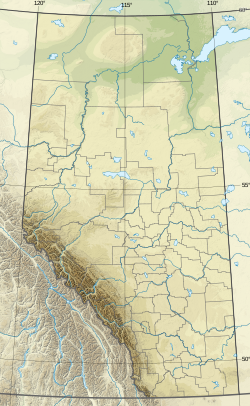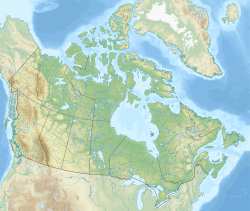Ranfurly is a hamlet in central Alberta, Canada within the County of Minburn No. 27.[2] Previously an incorporated municipality, Ranfurly dissolved from village status on January 1, 1946 to become part of the Municipal District of Birch Lake No. 484.[3]
Ranfurly | |
|---|---|
| Coordinates: 53°24′26″N 111°40′47″W / 53.40722°N 111.67972°W | |
| Country | Canada |
| Province | Alberta |
| Region | Central Alberta |
| Census division | 10 |
| Municipal district | County of Minburn No. 27 |
| Government | |
| • Type | Unincorporated |
| • Governing body | County of Minburn No. 27 Council |
| Area (2021)[1] | |
| • Land | 0.72 km2 (0.28 sq mi) |
| Population (2021)[1] | |
• Total | 71 |
| • Density | 98.6/km2 (255/sq mi) |
| Time zone | UTC−07:00 (MST) |
| • Summer (DST) | UTC−06:00 (MDT) |
| Area code(s) | 780, 587, 825 |
Ranfurly is located 1 kilometre (0.62 mi) north of Highway 16, approximately 121 kilometres (75 mi) east of Edmonton. It has an elevation of 670 m (2,200 ft).[4]
Demographics
editIn the 2021 Census of Population conducted by Statistics Canada, Ranfurly had a population of 71 living in 33 of its 35 total private dwellings, a change of 26.8% from its 2016 population of 56. With a land area of 0.72 km2 (0.28 sq mi), it had a population density of 98.6/km2 (255.4/sq mi) in 2021.[1]
As a designated place in the 2016 Census of Population conducted by Statistics Canada, Ranfurly had a population of 56 living in 28 of its 34 total private dwellings, a change of -18.8% from its 2011 population of 69. With a land area of 0.75 km2 (0.29 sq mi), it had a population density of 74.7/km2 (193.4/sq mi) in 2016.[5]
Climate
edit| Climate data for Ranfurly | |||||||||||||
|---|---|---|---|---|---|---|---|---|---|---|---|---|---|
| Month | Jan | Feb | Mar | Apr | May | Jun | Jul | Aug | Sep | Oct | Nov | Dec | Year |
| Record high °C (°F) | 15 (59) |
13.3 (55.9) |
22.8 (73.0) |
33.3 (91.9) |
36.1 (97.0) |
36.7 (98.1) |
40.6 (105.1) |
37.2 (99.0) |
34.5 (94.1) |
30 (86) |
22.8 (73.0) |
13.9 (57.0) |
40.6 (105.1) |
| Mean daily maximum °C (°F) | −9.5 (14.9) |
−6.8 (19.8) |
−0.5 (31.1) |
10.2 (50.4) |
17.9 (64.2) |
21.1 (70.0) |
22.7 (72.9) |
21.8 (71.2) |
15.7 (60.3) |
10.3 (50.5) |
−1.6 (29.1) |
−8 (18) |
7.8 (46.0) |
| Mean daily minimum °C (°F) | −19.4 (−2.9) |
−16.9 (1.6) |
−10.5 (13.1) |
−1.6 (29.1) |
4.5 (40.1) |
8.5 (47.3) |
10.6 (51.1) |
9.2 (48.6) |
4.1 (39.4) |
−0.9 (30.4) |
−10.1 (13.8) |
−17.4 (0.7) |
−3.3 (26.1) |
| Record low °C (°F) | −49.4 (−56.9) |
−51.2 (−60.2) |
−42.2 (−44.0) |
−32.2 (−26.0) |
−14.4 (6.1) |
−5.6 (21.9) |
−3.9 (25.0) |
−4.4 (24.1) |
−14.4 (6.1) |
−28.3 (−18.9) |
−40.6 (−41.1) |
−47.2 (−53.0) |
−51.2 (−60.2) |
| Average precipitation mm (inches) | 20.4 (0.80) |
12.5 (0.49) |
19.9 (0.78) |
19.9 (0.78) |
43.2 (1.70) |
79.2 (3.12) |
72.4 (2.85) |
65 (2.6) |
41.8 (1.65) |
14.5 (0.57) |
14.1 (0.56) |
23.8 (0.94) |
426.6 (16.80) |
| Average snowfall cm (inches) | 19.3 (7.6) |
12.1 (4.8) |
18.7 (7.4) |
13.3 (5.2) |
2.4 (0.9) |
0 (0) |
0 (0) |
0 (0) |
2 (0.8) |
7.5 (3.0) |
12.1 (4.8) |
22.7 (8.9) |
110.2 (43.4) |
| Source: Environment Canada[6] | |||||||||||||
See also
editReferences
edit- ^ a b c "Population and dwelling counts: Canada and designated places". Statistics Canada. February 9, 2022. Retrieved February 10, 2022.
- ^ "Specialized and Rural Municipalities and Their Communities" (PDF). Alberta Municipal Affairs. June 3, 2024. Retrieved June 14, 2024.
- ^ "Table 6a: Population by census divisions and subdivisions showing reorganization of rural areas, 1931-1946". Census of the Prairie Provinces, 1946. Vol. I: Population. Ottawa: Dominion Bureau of Statistics. 1949. p. 423.
- ^ "Alberta Private Sewage Systems 2009 Standard of Practice Handbook: Appendix A.3 Alberta Design Data (A.3.A. Alberta Climate Design Data by Town)" (PDF) (PDF). Safety Codes Council. January 2012. pp. 212–215 (PDF pages 226–229). Retrieved October 9, 2013.
- ^ "Population and dwelling counts, for Canada, provinces and territories, and designated places, 2016 and 2011 censuses – 100% data (Alberta)". Statistics Canada. February 8, 2017. Retrieved February 13, 2017.
- ^ "Canadian Climate Normals 1971–2000". Environment Canada. Retrieved May 5, 2013.

